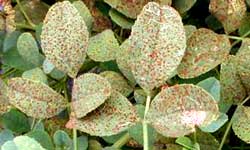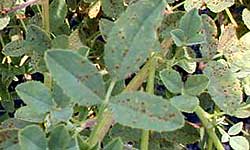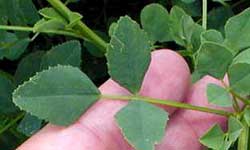Sweetclover Rust: An Emerging Disease?
Rust refers to a plant disease caused by a group of fungi that occur worldwide. This disease is common on wild and cultivated plants, and can be very destructive. Rusts are especially known on grain crops, but also attack vegetables, field crops, ornamentals, and trees. The name of this disease comes from the numerous, typically rust-colored spots that develop on leaves and stems of infected plants. Eventually, the spots burst through the leaf surface, exposing vast numbers of microscopic rust-colored spores. The tiny spores can land on nearby plants, or be carried great distances by wind currents. The spores then initiate a new cycle of infection on plants. Rust fungi have a complex life cycle; most have five different spore stages and require two different plant hosts (usually unrelated) to complete it.
 Sweetclover rust (Uromyces striatus) was first observed1 on sweetclover in Kansas in 1999, then also found in Florida in 2001. We discovered rust on sweetclover plants in Beeville, Texas, during the 2002-2003 growing season, and we have identified it as the same species of rust.
Sweetclover rust (Uromyces striatus) was first observed1 on sweetclover in Kansas in 1999, then also found in Florida in 2001. We discovered rust on sweetclover plants in Beeville, Texas, during the 2002-2003 growing season, and we have identified it as the same species of rust.
 Since then, we have evaluated over 85 lines of sweetclover (Melilotus alba) and identified four lines with various levels of resistance to sweetclover rust. Through multiple years of breeding and evaluation we have released a new cultivar of white flower sweetclover, ‘Silver River’, with high levels of rust resistance.
Since then, we have evaluated over 85 lines of sweetclover (Melilotus alba) and identified four lines with various levels of resistance to sweetclover rust. Through multiple years of breeding and evaluation we have released a new cultivar of white flower sweetclover, ‘Silver River’, with high levels of rust resistance.

Images on the right show (from top to bottom), highly susceptible, moderately resistant, and highly resistant, lines of sweetclover.